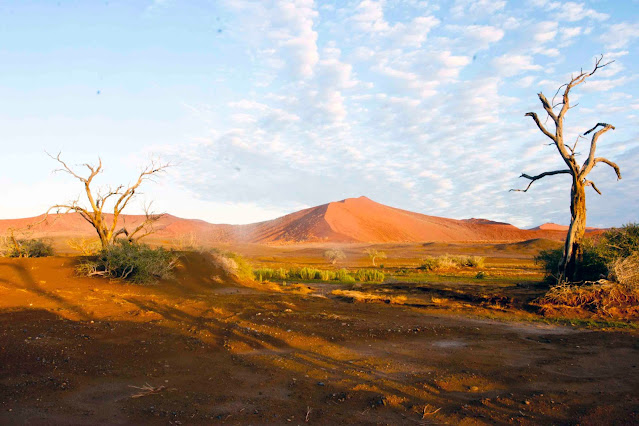 |
| The desert in living color. Normally there is no green. |
The top attraction in Namibia (competing with Etosha National Park) is arguably Sossusvlei, a salt and clay pan surrounded by high red dunes. I'll tell you straight away that we tried and failed to make it there. Still, we feel privileged rather than deprived.
 |
| We climbed one of the smaller dunes--high enough for us in the heat |
By all accounts, the dramatic dunes are a sight to behold. So we bit the bullet and shelled out the big money
to rent a four-wheel drive Ford Ranger to navigate the sand and gravel roads that make up
most of the six-plus-hour drive from Luderitz to Sesrium. We rationalized the extra cost as necessary because only four-wheel drive vehicles are allowed in the last four kilometers into Sossusvlei itself (if you don't want to depend on a paid shuttle service). With the local lodges running around $350 US per person per night, we opted for the cheaper, but still pricey campsite (over $80 US for camping--in your own tents--for the five of us). They came with power and personal showers and toilets, but it was still just camping. The one benefit of the campsite was that it was located inside of the park. That allowed us to get a head start as the park opens the inner gates that lead to Sossusvlei at 5:30 a.m. but doesn't open the main gate until 6:00 a.m.
We left Luderitz and had a stunning drive through some unreal landscapes that were made even more amazing due to the green hues and grasses covering the normally desolate red-brown of the desert. It's been an active summer here and the normally dry desert has been getting more rain than usual. After driving through a thunderstorm and a few sketchy bits of road, we made it to camp. We ended the day by watching the sun set over the dunes, enjoying a tasty oryx steak dinner, and having some drinks around the camp fire. Then off to bed as it was going to be another "up before the sunrise" outing.
OK, sorry to interrupt, but time for a bit of a sidebar rant. So we've been to a number of places where the "thing" was to get to a certain spot prior to sunrise in order to watch the sun rise over the mountain, sea, city scape or random goat or whatever. Of course, this usually means getting up at an uncivilized hour, stumbling around while trying to brush your teeth and making sure the underwear doesn't get put on backwards. Then it's off for a walk/drive/bumble, usually cold and certainly to the accompaniment of complaints from the children, to the pre-ordained perfect spot from which to watch the supposed miracle of the sun coming up. And almost invariably, when all is said and done, we've come to the conclusion that we could have just gotten up at close to a regular time and still experienced 99% of whatever it was. That extra 1% from seeing the very first ray of light is rarely worth the hassle of all that comes with it.
And yet, somehow, we always forget these hard learned conclusions, and allow ourselves to be convinced that this time it really WILL be worth it to get up early and see the first light hit the dune, scrubby tree, or scraggly chicken. This time was no different.
So, the next morning, we got ourselves up in the dark to time our arrival at the dunes for sunrise and drove along the unlit gravel road, narrowly missing a jackal that darted towards the truck. As we approached the Tsauchab River, which is a normally dry collection of dust and stones, we were met with 3 stopped vehicles and this:
 |
| Our friend and car mate Dave (Anjea). Those are 2-foot standing waves in the Tsauchab River, which is normally a dry river bed. |
This is a quote from the Sossusvlei travel site: "Sossusvlei literally translates to 'dead-end marsh', as it is the place where the dunes come together preventing the Tsauchab River to flow any further, some 60km east of the Atlantic Ocean. However, due to the dry conditions in the Namib Desert the river seldom flows this far and the pan remains bone-dry most years. During an exceptional rainy season the Tsauchab fills the pan, drawing visitors from all over the world to witness this spectacular site."
 |
| Why did the oryx cross the road? |
We waited an hour for the river to subside enough to cross, but it never did. We went back to camp to have a cup of coffee and give the river a bit more time to go down. Our second try was also unsuccessful. So, instead of going to Sossusvlei, we climbed the unnamed dune that sits just before the river crossing. By that time, it was 9 a.m. and the sun and sand were already scorching. Matt and Conrad made it to the top, but Mark and I decided to head down because we were feeling light-headed and the sand burned our bare feet. We are (or were, anyway) used to heat, but the desert sun is no joke.
 |
| Luderitz, a German mining town, where Perry is moored. |
By the time we left, the few vehicles that made it across to Sossusvlei before the river flooded were stranded and still waiting to come back to the Sesrium side. One intrepid man decided to try to wade into the river a few feet but quickly got out. It is ill-advised to wade in the waters. Besides the risk of being carried away, there can be snakes.
 |
| A wild desert horse |
We
have had many Namibians tell us how lucky we were to see the desert in
bloom and how rare it was for there to be water in the river. Local
tourism was up as Namibians flocked to the desert to witness the unusual
scene.
We ran out of time to wait for the river and needed to start the 6 hour journey back to Luderitz. We planned our route back and got about three miles out of Sesrium when we encountered another flooded river crossing blocking our way. After chatting with a local car that had been waiting for three hours to cross, we decided the only option was to wait for the water to go down and to head back to Sesrium and have some lunch. The prospect of not getting out and having to spend another night at the campsite was a real possibility. Luckily, a ranger at the restaurant told us of another crossing point where traffic had just recently been able to get through, so we headed that way after lunch. We made it across, after a few tense moments driving through the flowing water.
By the way, Matt later ran into the couple that was waiting for three hours (they have a house in Luderitz) and they never did get through. The spent another night in Sesrium.
 |
| Kolmanskop, the German diamond mining ghost town |
Our trip back was punctuated with heavy rain and a tire change. We're still not sure what we hit, but it did a number on our tire and we later ended up having to buy a new one. We were happy to make it back to Luderitz before dark. Despite never making it to Sossusvlei, we were witness to rare and spectacular scenery. We don't know what we missed, but we know that what we saw was beautiful.
 |
| Though abandoned for many decades, some of the Kolmanskop buildings look better than newer buildings we have seen in various parts of the world |
We quite like Luderitz and have enjoyed the best Eisbein we have had yet. The German influences in the architecture and food give the town a European feel (if you keep a narrow focus and ignore the desert just down the block). We spent a morning in Kolmanskop, the abandoned diamond mining town that once boasted the largest production of jewelry-grade diamonds and the highest per capita income in the world. All the building material, including sand (in a desert, mind you), was brought in from Germany.
 |
| A hallway in the krankenhaus (hospital) |
We also spent a day driving the peninsula around Luderitz, which still has diamond mining and processing operations. There are many lovely bays and rocky hills, with seals, penguins, and flamingos.
 |
| The flamingos are not as pink as some but have a lovely color when they fly. |
On the sailing front, our trip from Cape Town to Namibia was mostly uneventful, if a bit slow due to a lull in the wind. The whisker pole failed again, which Matt has already fixed (hopefully more robustly this time).
The bigger issue on the passage was that our satellite phone connection was nearly unusable, making it essentially impossible to download weather data and emails. With our provider unable/unwilling to help us fix the problem, we were facing an Atlantic crossing without good weather information or reliable communication.
Fortunately, our friends Andrew and Leslie on Sonrisa, who were still in Cape Town, found and bought an Iridium Go! for us and got it to our friends Paul and Chris on Georgia before they left Cape Town for Luderitz--all while we were mostly out of cell phone range on our Sossusvlei trip. A few days later, Georgia arrived in Luderitz after a fast and sporty passage and we now have our new Go! in hand. Dave on Anjea has been kind enough to sell us the SIM card we need. We have amazing friends and this was one of the times when we have been blessed with good timing. Once we get the Go! working, we can start moving north towards Walvis Bay. The Atlantic crossing gets closer and closer.



How amazing! Those desert pictures are beautiful with the red dunes!
ReplyDeleteThanks--we really enjoyed it!
DeleteA-MA-ZiNG ! Your photos and your story telling ! I’m simply blown away here in my little sheltered life ! I had to laugh at your rant about sunrise clauses .... it’s true ! We’ve experienced very similar FOMO around the world over the years, but we always end up getting up with everyone else ! The only one That truly had me in tears was Machu Pichhu.... I can’t believe you guys are getting close to crossing back to this side.... feels surreal . Well, I’m glad you got your phone sorted out - keep having fun out there !
ReplyDeleteThanks! I know (nail biting...)! Hopefully we will still make it to Machu Picchu one of these days.
Delete